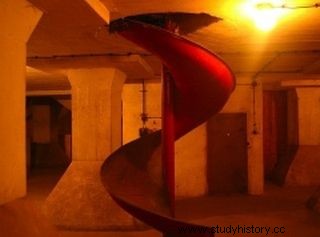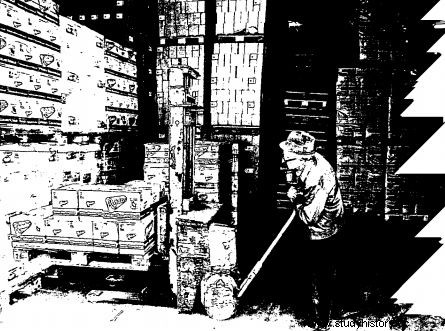The authorities of West Berlin must have had something of the dragons known from fairy tales and legends. They were also collecting treasures! And they were by no means limited to gold or valuables. Everything of any value landed in the gigantic bunkers and warehouses. What didn't also.
Immediately after the end of the famous blockade of Berlin, local authorities began to prepare in case of its repetition. From August 1949, a so-called "Senate reserve" was created. Why is this topic worth describing? Well, this reserve was really record size. As Wilfried Rott writes in his book "Wyspa. The history of West Berlin " goods were distributed in 200 places in the city and occupied 64 hectares of free space and 42 hectares of halls, cold stores and freezers (p. 76) .

Former Senate Reserve magazine in a photo on Flickr (peaceproductions user).
These are only official data. The entire operation was conducted in the strictest secrecy, so there had to be many more warehouses in reality. One hundred people from a special department working for the city's Senate handled the reserve.
1.5 million tons of hard coal has been accumulated underground which in the event of a crisis would be enough for the entire city for five months. There were even attempts to locate a coal deposit near Berlin and start a municipal mine, but nothing came of it. In addition, mainly slowly perishable food products were stored. The warehouses of flour, sugar, crisp bread or peas are unlikely to surprise anyone. But the other reserves were exotic to say the least.
The warehouses contained everything from medicines to matches, and even… dental gold. Tens of thousands of canned fish were stored at one of the stations. In an ordinary building in Kreuzberg - enormous amounts of glass.

The Senate's reserve even included ... sauerkraut (Der Spiegel, 34/1990).
Elsewhere, thousands of plastic potties were stored . There were also… clothes and bicycles. Wilfried Rott says:
The fate of these government reserves, which, to the delight of traders, had to be constantly renewed, was variable. Gradually, clothes for residents were no longer stored, as it turned out to be quite unfashionable during the sale. Finally, the collection of bicycles prepared as an emergency means of communication for officials was also abandoned, which was pleased by consumers who can appreciate the advantages of cheaply sold vehicles (p. 77).

The article is based mainly on the book by Wilfired Rott entitled "Island. The history of West Berlin 1948-1990 ”(PWN 2011).
How did it all look like in numbers? According to a 1994 press article, the provision included: 189,000 tons of grain, 44,000 tons of meat, 7,130 tons of salt, 96 tons of mustard, 291,000 pieces of children's shoes, 380 tons of shoe soles, 20 tons of glue, 4 million light bulbs and 18 million rolls of toilet paper .
The maintenance of the reserve cost a hundred million marks a year. It was only in the 1980s that wider information about it began to reach the public opinion. At that time, such a gigantic expense seemed completely unnecessary and the residents strongly protested against it. Nevertheless, the shrinking reserve was kept until 1989!
In the meantime, many warehouses have been lost forever and no one remembers their exact location. There are probably tens of thousands of canned food, sanitary napkins and toothbrushes near Berlin, just waiting for brave treasure hunters ...
